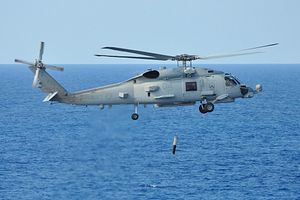On July 27, U.S. defense contractor Lockheed Martin handed over the 24th and final MH-60R Seahawk Romeo anti-submarine warfare helicopter to the U.S. Navy in support of the Royal Australian Navy’s (RAN) push to modernize its aerial anti-submarine warfare capabilities, according to a company press release.
The transfer occurred under the Pentagon’s Foreign Military Sales (FMS) program, managed by the U.S. Defense Security Cooperation Agency, the lead agency within the U.S. Department of Defense responsible for arms sales to allied nations. The $2.2 billion arms deal for 24 MH-60R helicopters was originally announced in July 2010.
A final contract was signed in June 2011 to fulfill the Australian military’s requirement for a fleet of 24 multi-role naval combat aircraft to replace the RAN’s 16 aging S-70B-2 Seahawk helicopters, which have been in service since 1989. Australia became the first international customer of the new MH-60R. The first mission-ready aircraft was delivered in 2014.
The MH-60 is primarily designed for conducting anti-submarine and anti-surface warfare missions. However, it can also be deployed in search and rescue, vertical replenishment, naval surface fire support, logistics support, and personnel transport, as well as medical evacuation operations. The helicopters are armed with Hellfire air-to-surface missiles and the Mark 54 anti-submarine torpedo.
The aircraft will be deployed aboard the RAN’s Anzac-class frigates and the new the Hobart-class air warfare destroyers. “Navy will have the capacity to provide at least eight warships with a combat helicopter at the same time, including Anzac Class frigates and the new Air Warfare Destroyers. The remainder will be based at HMAS Albatross in Nowra, New South Wales, and will be in various stages of the regular maintenance and training cycle,” according to the RAN website.
The handover ceremony for the 24th helicopter took place at Lockheed Martin’s Oswego, New York plant. “The Royal Australian Navy has formed the first three embarked flights, conducted the first Hellfire Missile shoot, and conducted a highly successful ‘DIPEX’ [an anti-submarine warfare drill] against a Collins Class submarine,” said RAN Commodore Scott Lockey, the Director General for Navy Aviation Systems, during the ceremony, describing the most recent efforts to integrate the new weapons platform in the Australian navy.
A quarter of Australia’s defense spending will be dedicated to expanding the RAN’s combat capabilities over the next ten years. It will be “the most comprehensive regeneration of our Navy since the Second World War,” according to Australia’s 2016 Defense White Paper (See: “Australia’s Defense Budget to Jump 81 % Over Next Decade”). Next to introducing 24 MH-60R helicopters, the Australia will induct seven MQ-4C Triton unmanned aerial vehicles and a total of 15 P-8A Poseidon maritime patrol aircraft into service by the late 2020s.

































